Geography 120, Spring '18: Lab 3 - Climographs, Cyclones & Satellites
VerifiedAdded on 2023/06/15
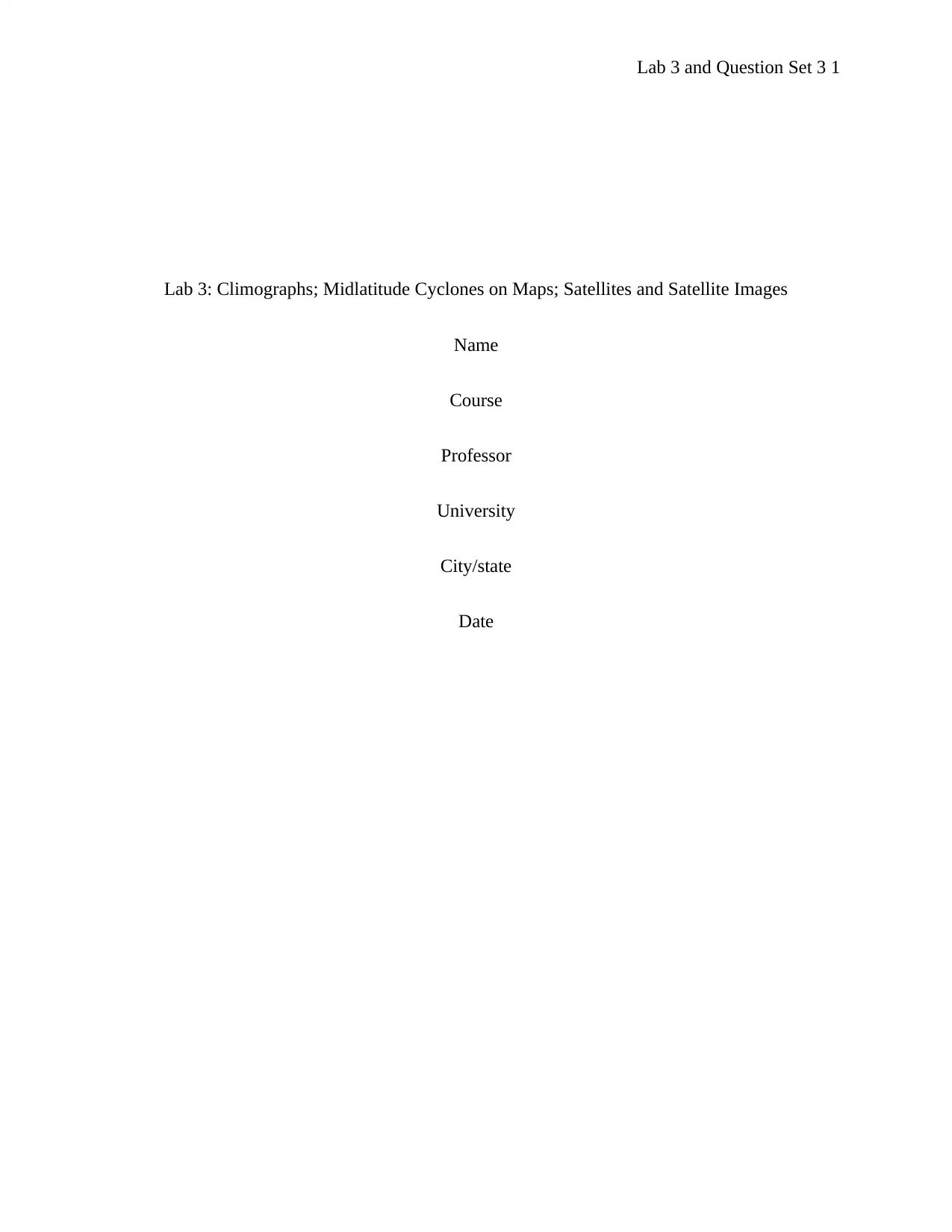
Lab 3: Climographs; Midlatitude Cyclones on Maps; Satellites and Satellite Images
Name
Course
Professor
University
City/state
Date
Paraphrase This Document
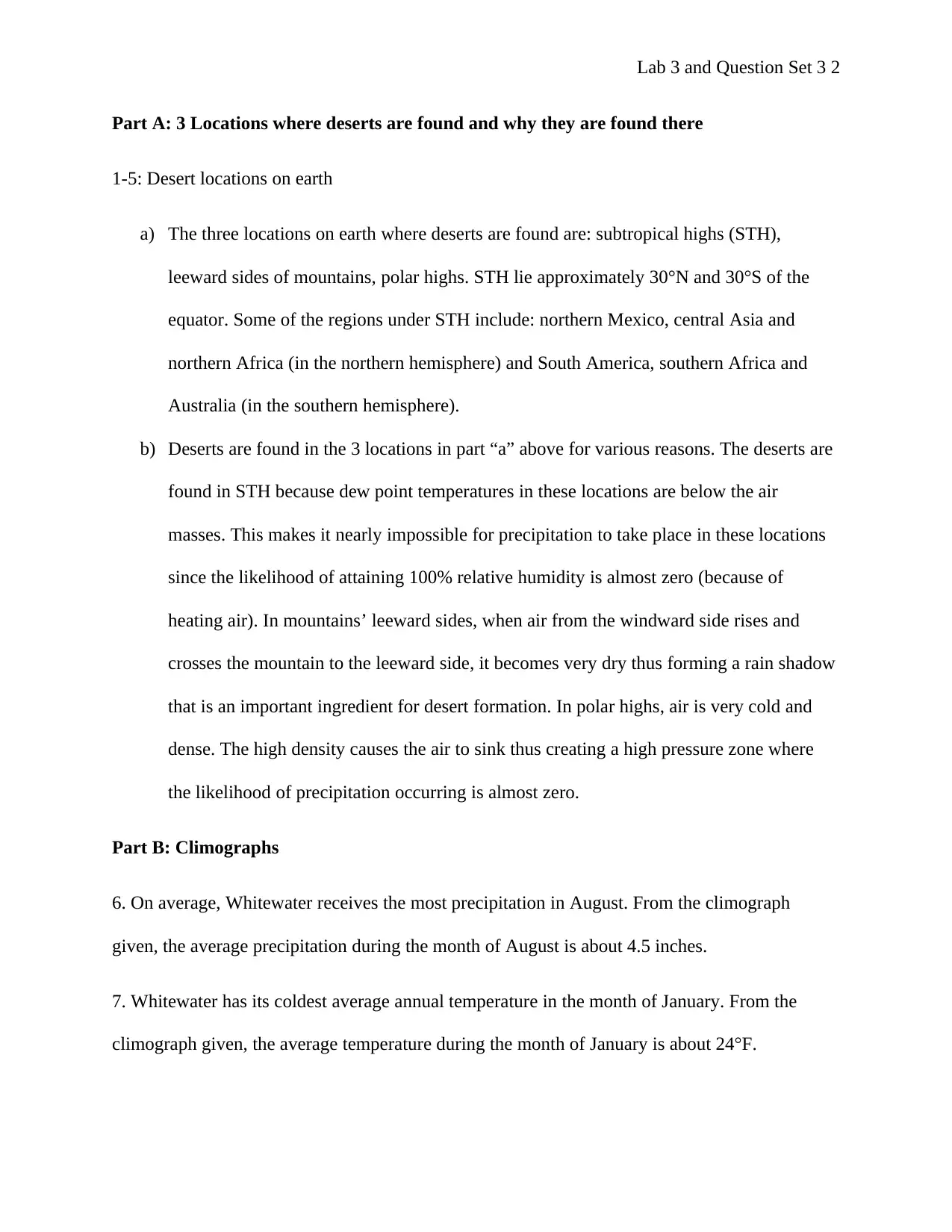
Part A: 3 Locations where deserts are found and why they are found there
1-5: Desert locations on earth
a) The three locations on earth where deserts are found are: subtropical highs (STH),
leeward sides of mountains, polar highs. STH lie approximately 30°N and 30°S of the
equator. Some of the regions under STH include: northern Mexico, central Asia and
northern Africa (in the northern hemisphere) and South America, southern Africa and
Australia (in the southern hemisphere).
b) Deserts are found in the 3 locations in part “a” above for various reasons. The deserts are
found in STH because dew point temperatures in these locations are below the air
masses. This makes it nearly impossible for precipitation to take place in these locations
since the likelihood of attaining 100% relative humidity is almost zero (because of
heating air). In mountains’ leeward sides, when air from the windward side rises and
crosses the mountain to the leeward side, it becomes very dry thus forming a rain shadow
that is an important ingredient for desert formation. In polar highs, air is very cold and
dense. The high density causes the air to sink thus creating a high pressure zone where
the likelihood of precipitation occurring is almost zero.
Part B: Climographs
6. On average, Whitewater receives the most precipitation in August. From the climograph
given, the average precipitation during the month of August is about 4.5 inches.
7. Whitewater has its coldest average annual temperature in the month of January. From the
climograph given, the average temperature during the month of January is about 24°F.
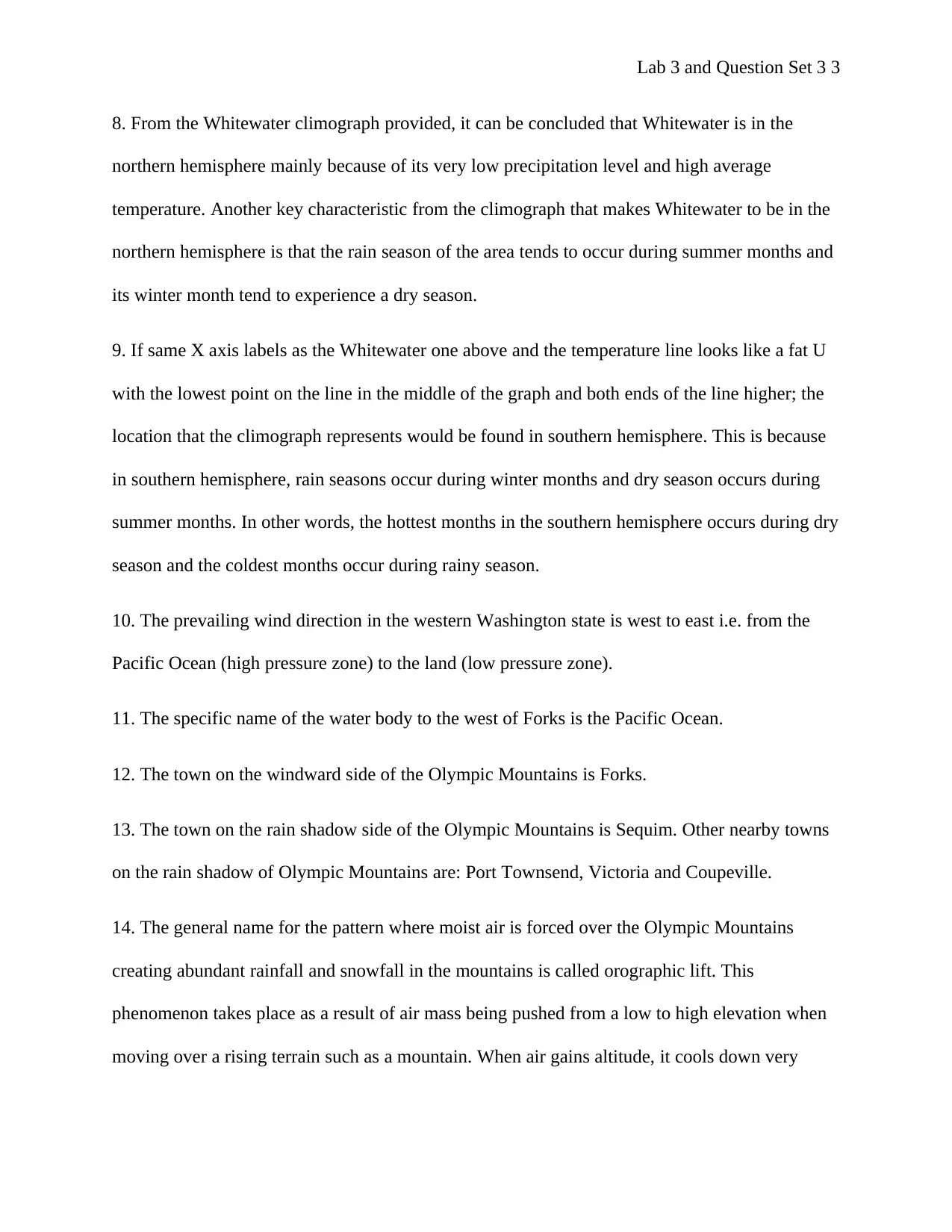
8. From the Whitewater climograph provided, it can be concluded that Whitewater is in the
northern hemisphere mainly because of its very low precipitation level and high average
temperature. Another key characteristic from the climograph that makes Whitewater to be in the
northern hemisphere is that the rain season of the area tends to occur during summer months and
its winter month tend to experience a dry season.
9. If same X axis labels as the Whitewater one above and the temperature line looks like a fat U
with the lowest point on the line in the middle of the graph and both ends of the line higher; the
location that the climograph represents would be found in southern hemisphere. This is because
in southern hemisphere, rain seasons occur during winter months and dry season occurs during
summer months. In other words, the hottest months in the southern hemisphere occurs during dry
season and the coldest months occur during rainy season.
10. The prevailing wind direction in the western Washington state is west to east i.e. from the
Pacific Ocean (high pressure zone) to the land (low pressure zone).
11. The specific name of the water body to the west of Forks is the Pacific Ocean.
12. The town on the windward side of the Olympic Mountains is Forks.
13. The town on the rain shadow side of the Olympic Mountains is Sequim. Other nearby towns
on the rain shadow of Olympic Mountains are: Port Townsend, Victoria and Coupeville.
14. The general name for the pattern where moist air is forced over the Olympic Mountains
creating abundant rainfall and snowfall in the mountains is called orographic lift. This
phenomenon takes place as a result of air mass being pushed from a low to high elevation when
moving over a rising terrain such as a mountain. When air gains altitude, it cools down very
⊘ This is a preview!⊘
Do you want full access?
Subscribe today to unlock all pages.

Trusted by 1+ million students worldwide
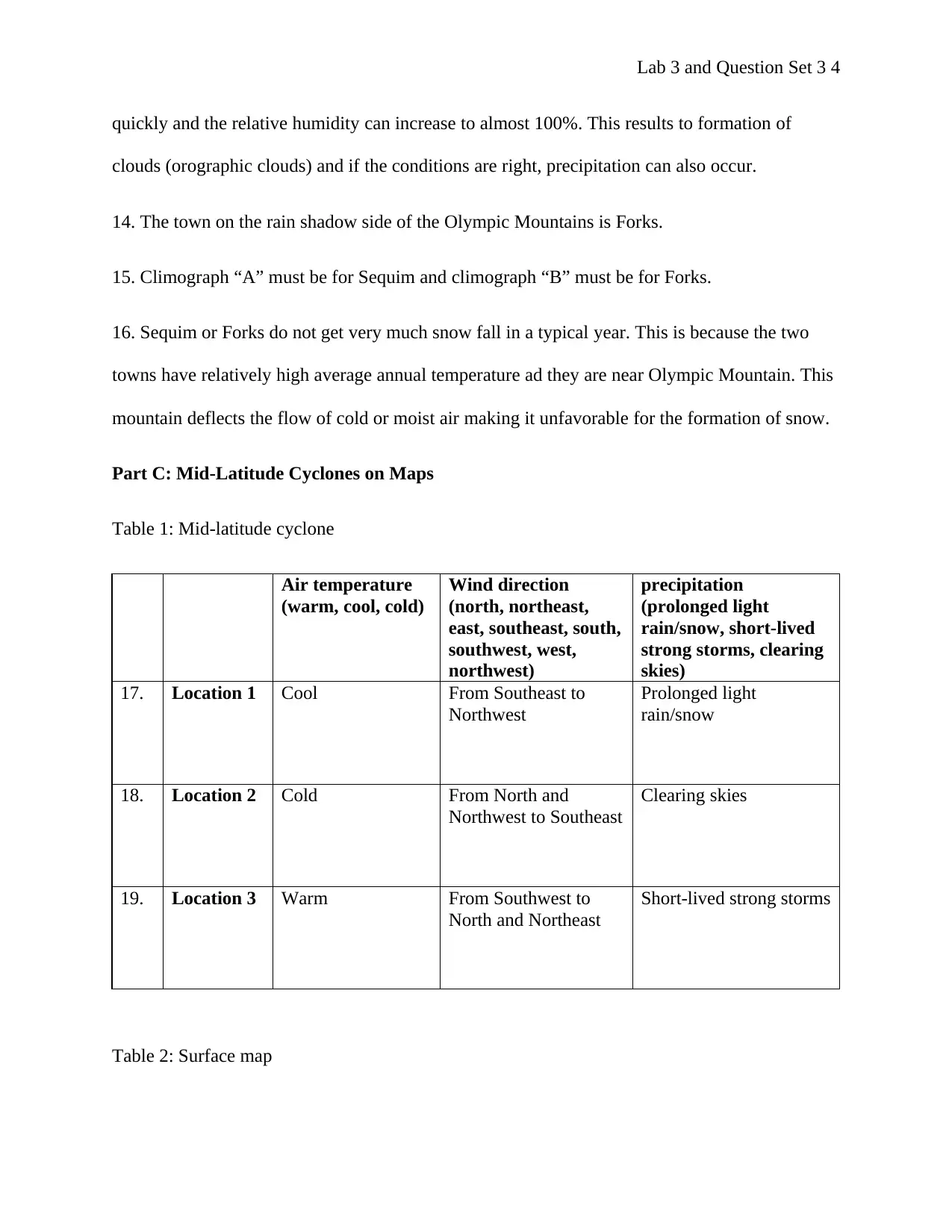
quickly and the relative humidity can increase to almost 100%. This results to formation of
clouds (orographic clouds) and if the conditions are right, precipitation can also occur.
14. The town on the rain shadow side of the Olympic Mountains is Forks.
15. Climograph “A” must be for Sequim and climograph “B” must be for Forks.
16. Sequim or Forks do not get very much snow fall in a typical year. This is because the two
towns have relatively high average annual temperature ad they are near Olympic Mountain. This
mountain deflects the flow of cold or moist air making it unfavorable for the formation of snow.
Part C: Mid-Latitude Cyclones on Maps
Table 1: Mid-latitude cyclone
Air temperature
(warm, cool, cold)
Wind direction
(north, northeast,
east, southeast, south,
southwest, west,
northwest)
precipitation
(prolonged light
rain/snow, short-lived
strong storms, clearing
skies)
17. Location 1 Cool From Southeast to
Northwest
Prolonged light
rain/snow
18. Location 2 Cold From North and
Northwest to Southeast
Clearing skies
19. Location 3 Warm From Southwest to
North and Northeast
Short-lived strong storms
Table 2: Surface map
Paraphrase This Document
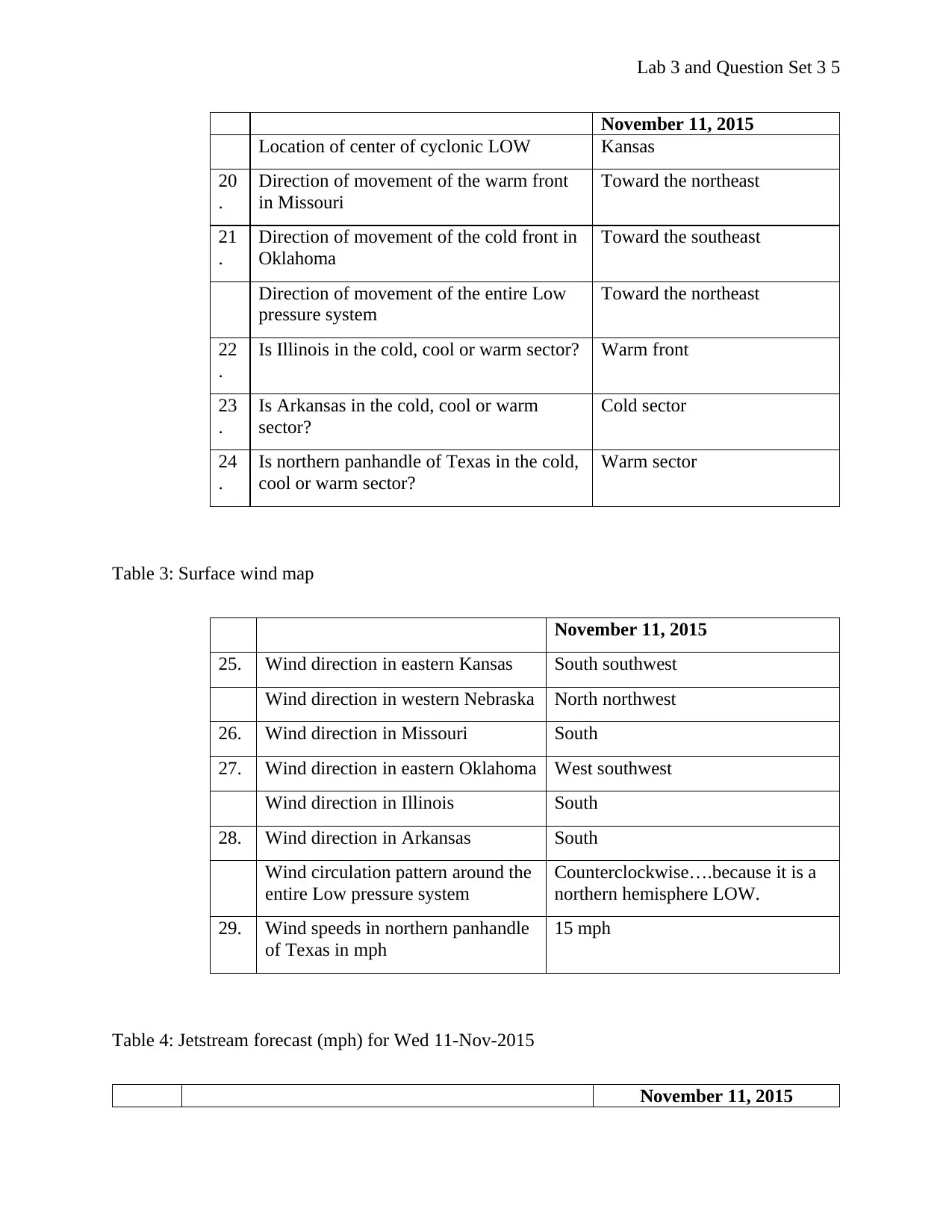
November 11, 2015
Location of center of cyclonic LOW Kansas
20
.
Direction of movement of the warm front
in Missouri
Toward the northeast
21
.
Direction of movement of the cold front in
Oklahoma
Toward the southeast
Direction of movement of the entire Low
pressure system
Toward the northeast
22
.
Is Illinois in the cold, cool or warm sector? Warm front
23
.
Is Arkansas in the cold, cool or warm
sector?
Cold sector
24
.
Is northern panhandle of Texas in the cold,
cool or warm sector?
Warm sector
Table 3: Surface wind map
November 11, 2015
25. Wind direction in eastern Kansas South southwest
Wind direction in western Nebraska North northwest
26. Wind direction in Missouri South
27. Wind direction in eastern Oklahoma West southwest
Wind direction in Illinois South
28. Wind direction in Arkansas South
Wind circulation pattern around the
entire Low pressure system
Counterclockwise….because it is a
northern hemisphere LOW.
29. Wind speeds in northern panhandle
of Texas in mph
15 mph
Table 4: Jetstream forecast (mph) for Wed 11-Nov-2015
November 11, 2015
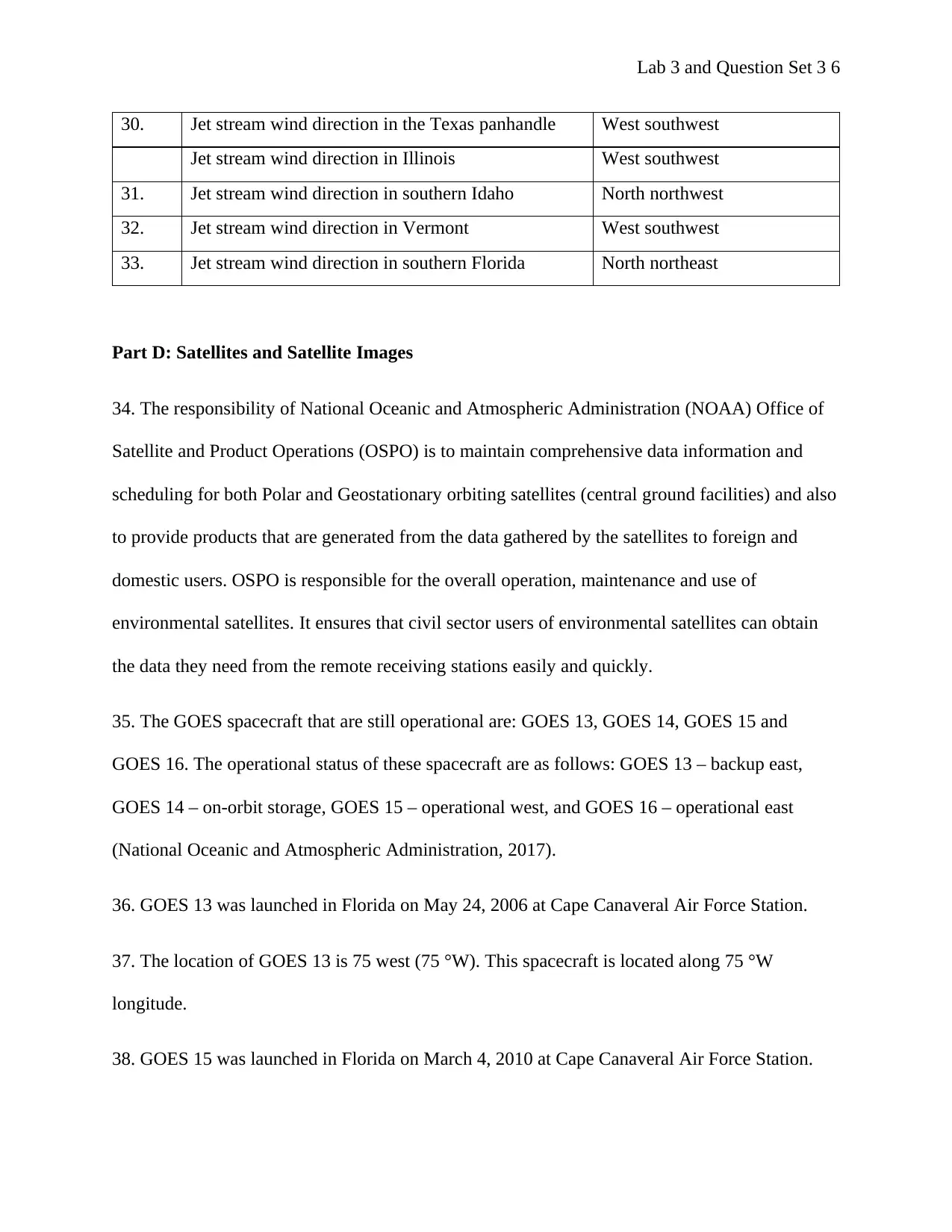
30. Jet stream wind direction in the Texas panhandle West southwest
Jet stream wind direction in Illinois West southwest
31. Jet stream wind direction in southern Idaho North northwest
32. Jet stream wind direction in Vermont West southwest
33. Jet stream wind direction in southern Florida North northeast
Part D: Satellites and Satellite Images
34. The responsibility of National Oceanic and Atmospheric Administration (NOAA) Office of
Satellite and Product Operations (OSPO) is to maintain comprehensive data information and
scheduling for both Polar and Geostationary orbiting satellites (central ground facilities) and also
to provide products that are generated from the data gathered by the satellites to foreign and
domestic users. OSPO is responsible for the overall operation, maintenance and use of
environmental satellites. It ensures that civil sector users of environmental satellites can obtain
the data they need from the remote receiving stations easily and quickly.
35. The GOES spacecraft that are still operational are: GOES 13, GOES 14, GOES 15 and
GOES 16. The operational status of these spacecraft are as follows: GOES 13 – backup east,
GOES 14 – on-orbit storage, GOES 15 – operational west, and GOES 16 – operational east
(National Oceanic and Atmospheric Administration, 2017).
36. GOES 13 was launched in Florida on May 24, 2006 at Cape Canaveral Air Force Station.
37. The location of GOES 13 is 75 west (75 °W). This spacecraft is located along 75 °W
longitude.
38. GOES 15 was launched in Florida on March 4, 2010 at Cape Canaveral Air Force Station.
⊘ This is a preview!⊘
Do you want full access?
Subscribe today to unlock all pages.

Trusted by 1+ million students worldwide
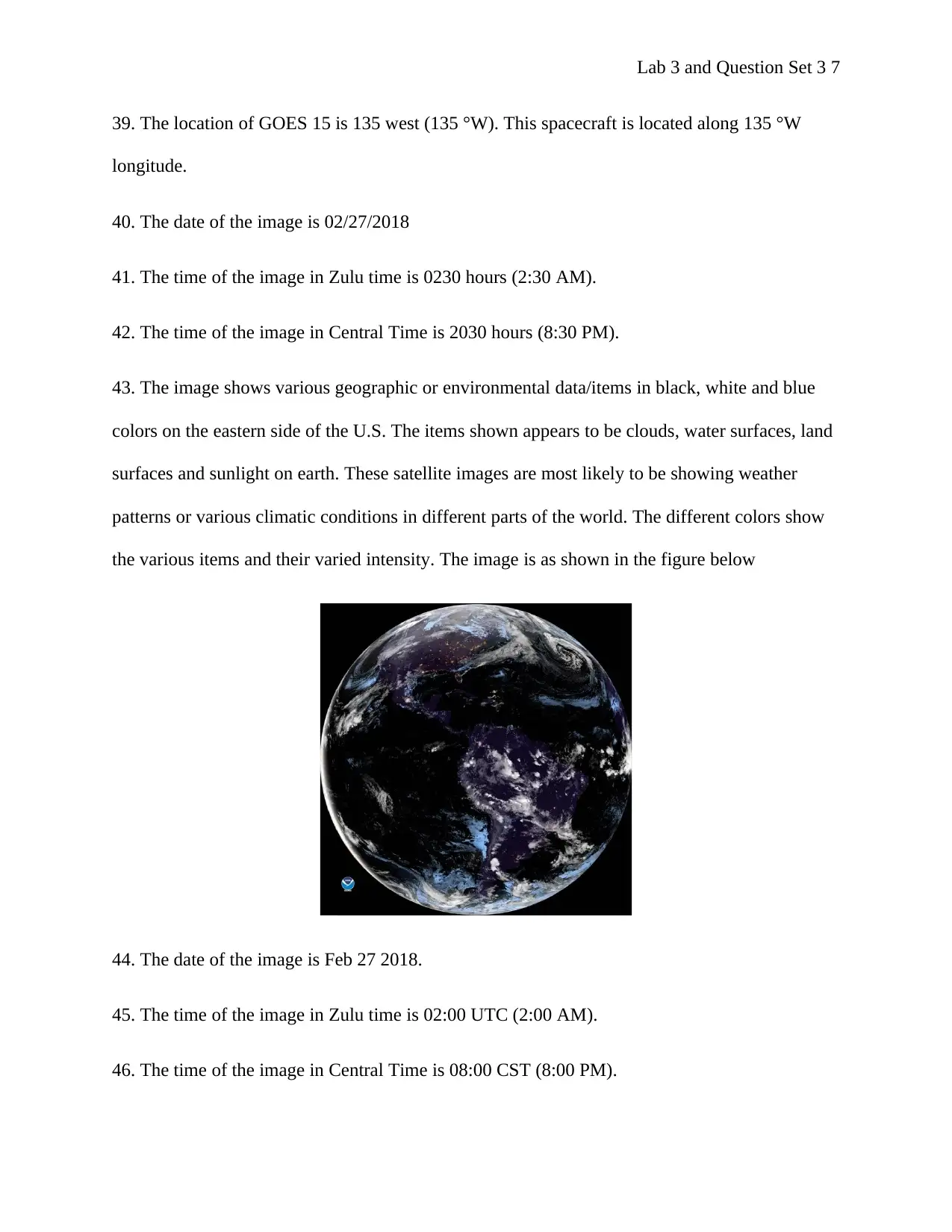
39. The location of GOES 15 is 135 west (135 °W). This spacecraft is located along 135 °W
longitude.
40. The date of the image is 02/27/2018
41. The time of the image in Zulu time is 0230 hours (2:30 AM).
42. The time of the image in Central Time is 2030 hours (8:30 PM).
43. The image shows various geographic or environmental data/items in black, white and blue
colors on the eastern side of the U.S. The items shown appears to be clouds, water surfaces, land
surfaces and sunlight on earth. These satellite images are most likely to be showing weather
patterns or various climatic conditions in different parts of the world. The different colors show
the various items and their varied intensity. The image is as shown in the figure below
44. The date of the image is Feb 27 2018.
45. The time of the image in Zulu time is 02:00 UTC (2:00 AM).
46. The time of the image in Central Time is 08:00 CST (8:00 PM).
Paraphrase This Document
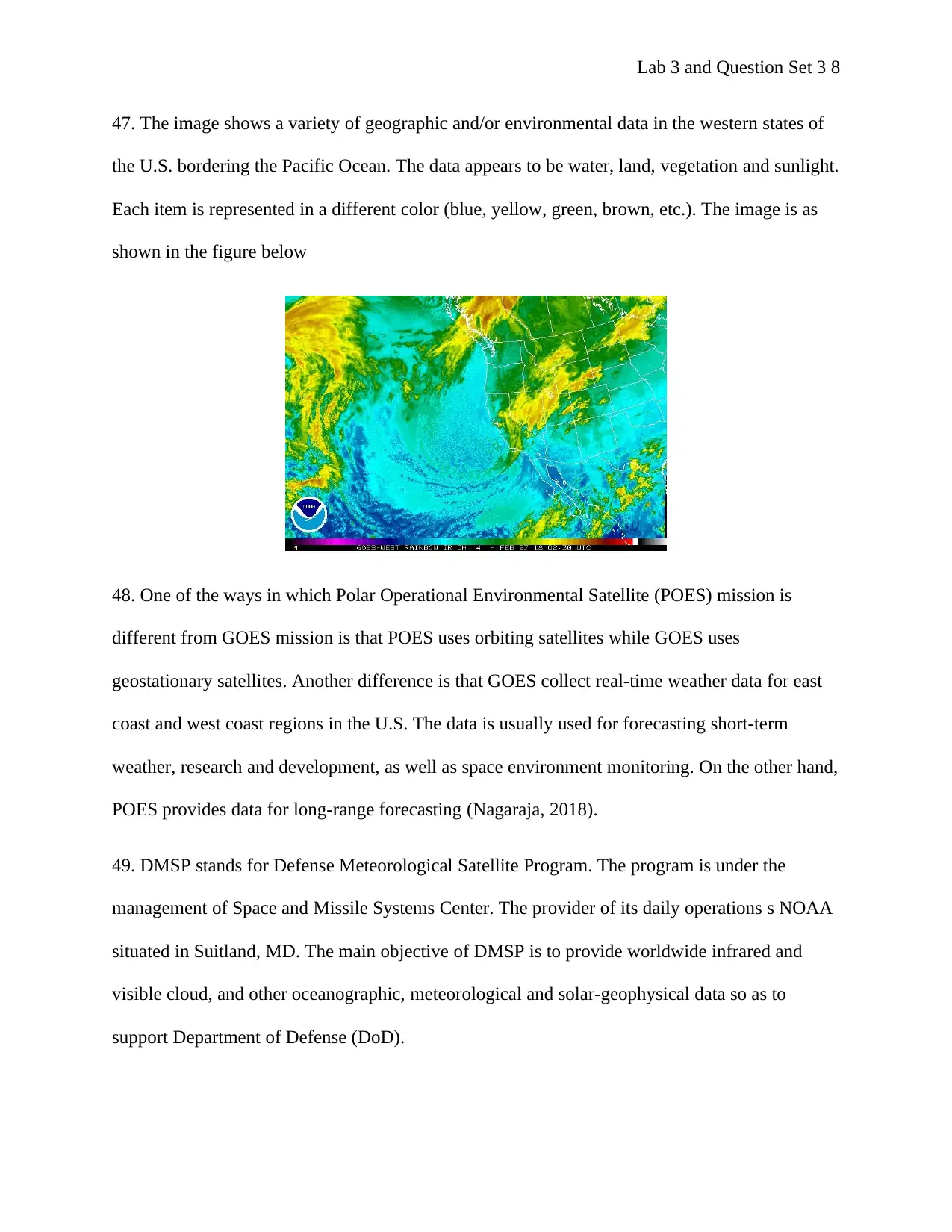
47. The image shows a variety of geographic and/or environmental data in the western states of
the U.S. bordering the Pacific Ocean. The data appears to be water, land, vegetation and sunlight.
Each item is represented in a different color (blue, yellow, green, brown, etc.). The image is as
shown in the figure below
48. One of the ways in which Polar Operational Environmental Satellite (POES) mission is
different from GOES mission is that POES uses orbiting satellites while GOES uses
geostationary satellites. Another difference is that GOES collect real-time weather data for east
coast and west coast regions in the U.S. The data is usually used for forecasting short-term
weather, research and development, as well as space environment monitoring. On the other hand,
POES provides data for long-range forecasting (Nagaraja, 2018).
49. DMSP stands for Defense Meteorological Satellite Program. The program is under the
management of Space and Missile Systems Center. The provider of its daily operations s NOAA
situated in Suitland, MD. The main objective of DMSP is to provide worldwide infrared and
visible cloud, and other oceanographic, meteorological and solar-geophysical data so as to
support Department of Defense (DoD).
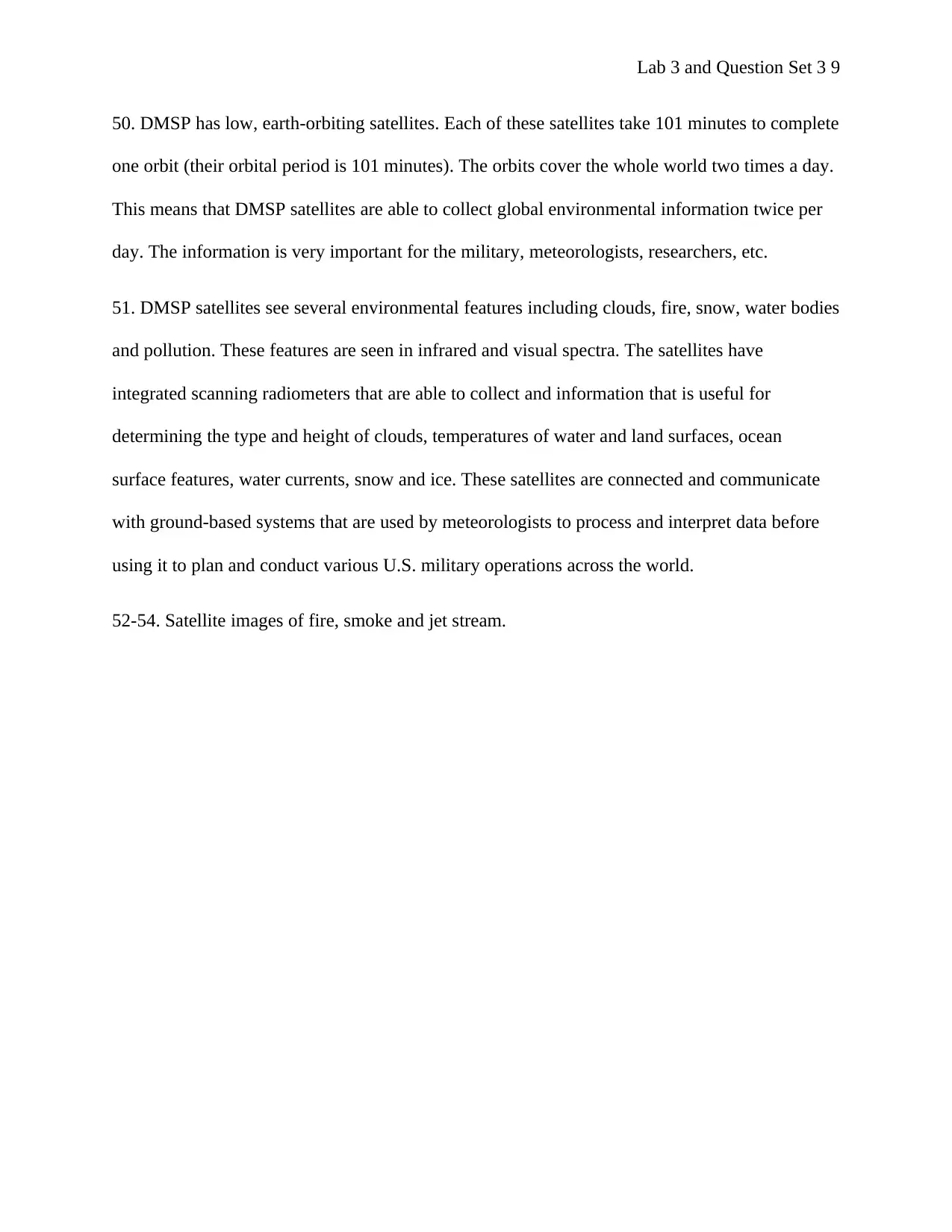
50. DMSP has low, earth-orbiting satellites. Each of these satellites take 101 minutes to complete
one orbit (their orbital period is 101 minutes). The orbits cover the whole world two times a day.
This means that DMSP satellites are able to collect global environmental information twice per
day. The information is very important for the military, meteorologists, researchers, etc.
51. DMSP satellites see several environmental features including clouds, fire, snow, water bodies
and pollution. These features are seen in infrared and visual spectra. The satellites have
integrated scanning radiometers that are able to collect and information that is useful for
determining the type and height of clouds, temperatures of water and land surfaces, ocean
surface features, water currents, snow and ice. These satellites are connected and communicate
with ground-based systems that are used by meteorologists to process and interpret data before
using it to plan and conduct various U.S. military operations across the world.
52-54. Satellite images of fire, smoke and jet stream.
⊘ This is a preview!⊘
Do you want full access?
Subscribe today to unlock all pages.

Trusted by 1+ million students worldwide
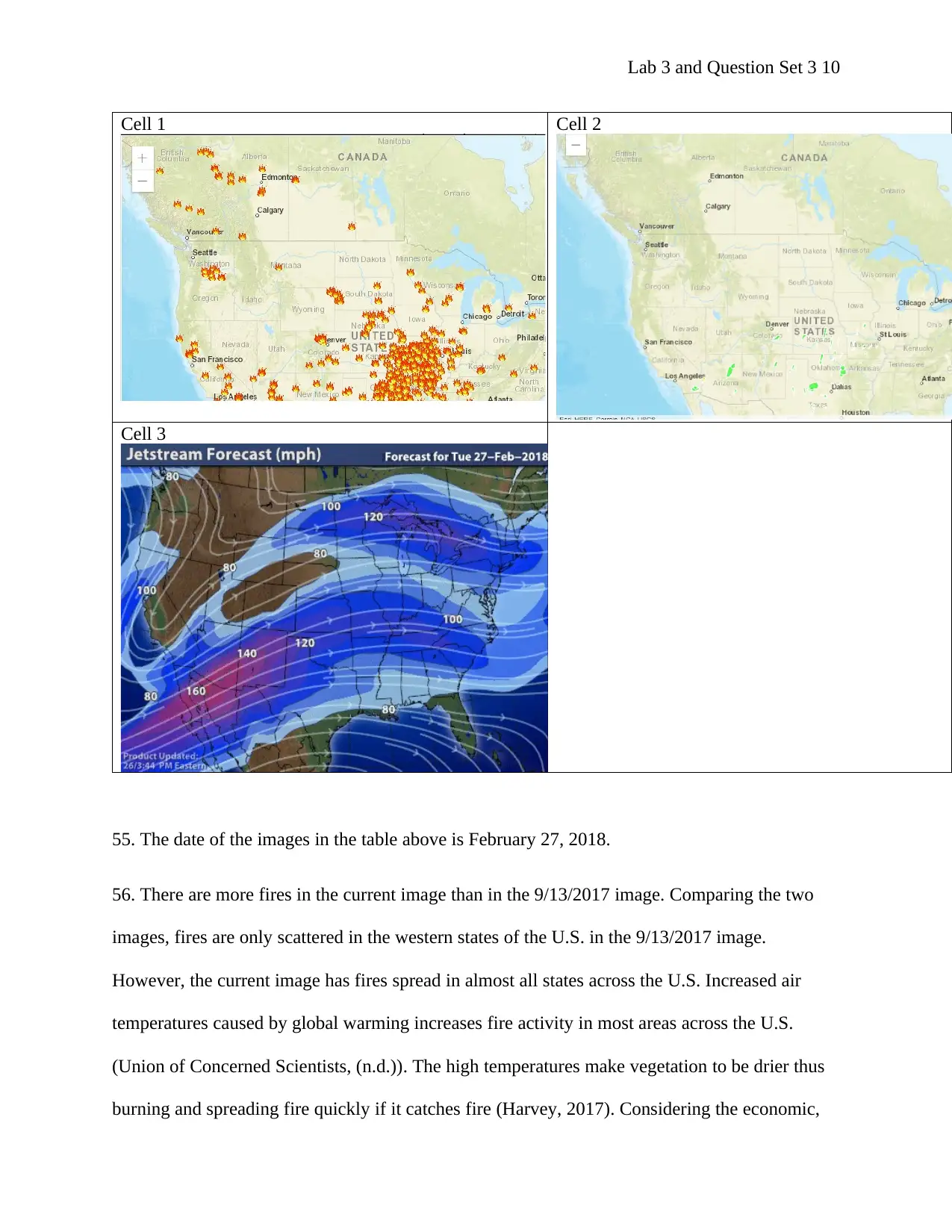
Cell 1 Cell 2
Cell 3
55. The date of the images in the table above is February 27, 2018.
56. There are more fires in the current image than in the 9/13/2017 image. Comparing the two
images, fires are only scattered in the western states of the U.S. in the 9/13/2017 image.
However, the current image has fires spread in almost all states across the U.S. Increased air
temperatures caused by global warming increases fire activity in most areas across the U.S.
(Union of Concerned Scientists, (n.d.)). The high temperatures make vegetation to be drier thus
burning and spreading fire quickly if it catches fire (Harvey, 2017). Considering the economic,
Paraphrase This Document
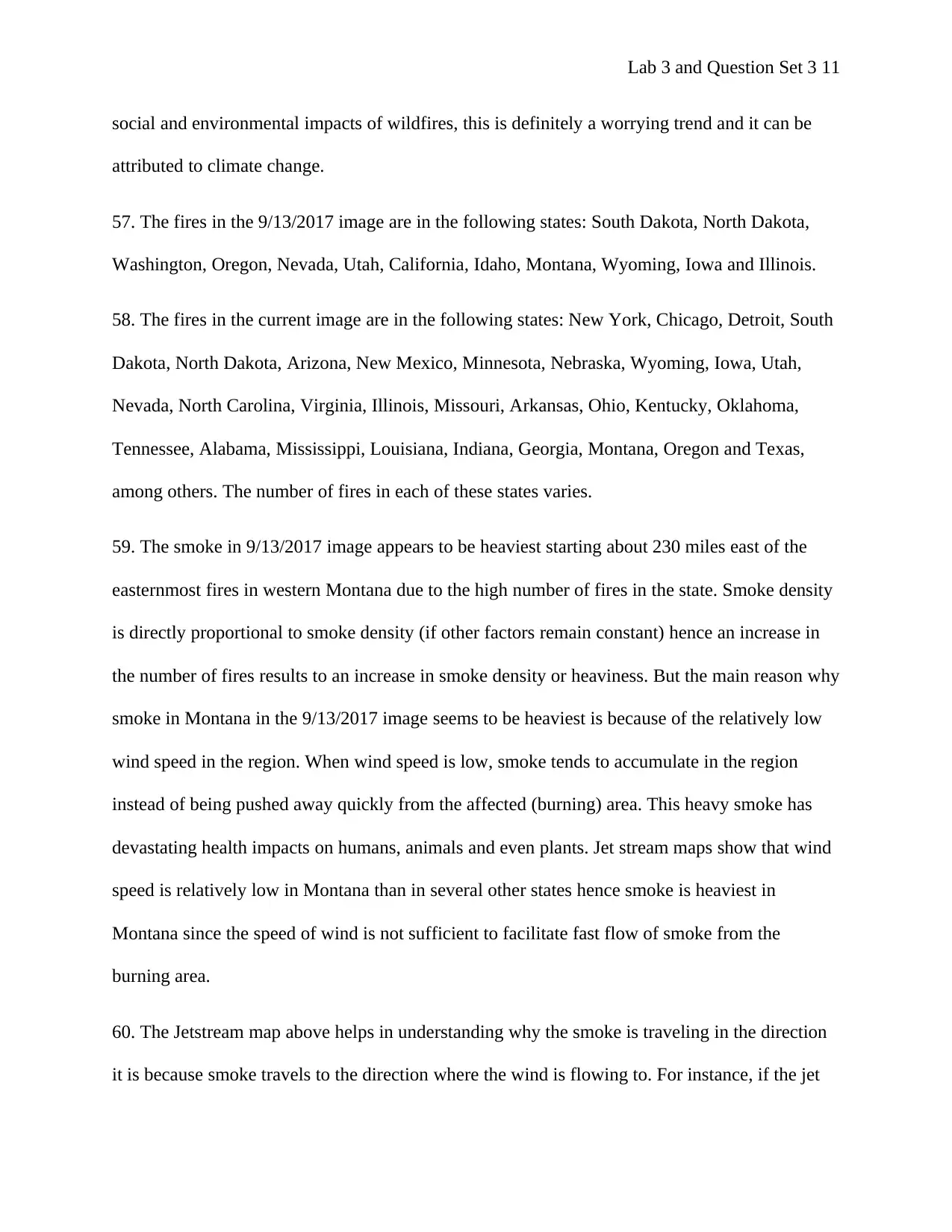
social and environmental impacts of wildfires, this is definitely a worrying trend and it can be
attributed to climate change.
57. The fires in the 9/13/2017 image are in the following states: South Dakota, North Dakota,
Washington, Oregon, Nevada, Utah, California, Idaho, Montana, Wyoming, Iowa and Illinois.
58. The fires in the current image are in the following states: New York, Chicago, Detroit, South
Dakota, North Dakota, Arizona, New Mexico, Minnesota, Nebraska, Wyoming, Iowa, Utah,
Nevada, North Carolina, Virginia, Illinois, Missouri, Arkansas, Ohio, Kentucky, Oklahoma,
Tennessee, Alabama, Mississippi, Louisiana, Indiana, Georgia, Montana, Oregon and Texas,
among others. The number of fires in each of these states varies.
59. The smoke in 9/13/2017 image appears to be heaviest starting about 230 miles east of the
easternmost fires in western Montana due to the high number of fires in the state. Smoke density
is directly proportional to smoke density (if other factors remain constant) hence an increase in
the number of fires results to an increase in smoke density or heaviness. But the main reason why
smoke in Montana in the 9/13/2017 image seems to be heaviest is because of the relatively low
wind speed in the region. When wind speed is low, smoke tends to accumulate in the region
instead of being pushed away quickly from the affected (burning) area. This heavy smoke has
devastating health impacts on humans, animals and even plants. Jet stream maps show that wind
speed is relatively low in Montana than in several other states hence smoke is heaviest in
Montana since the speed of wind is not sufficient to facilitate fast flow of smoke from the
burning area.
60. The Jetstream map above helps in understanding why the smoke is traveling in the direction
it is because smoke travels to the direction where the wind is flowing to. For instance, if the jet
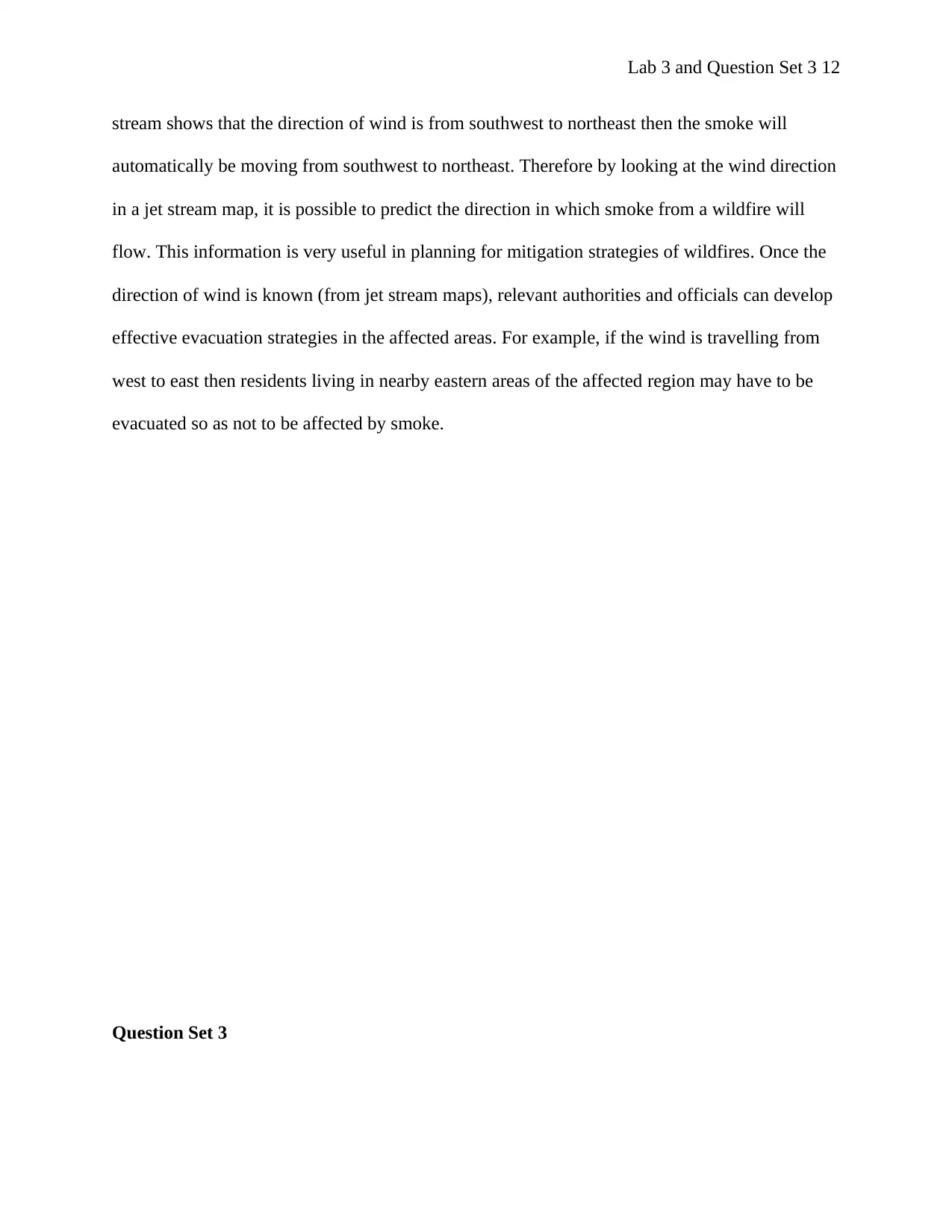
stream shows that the direction of wind is from southwest to northeast then the smoke will
automatically be moving from southwest to northeast. Therefore by looking at the wind direction
in a jet stream map, it is possible to predict the direction in which smoke from a wildfire will
flow. This information is very useful in planning for mitigation strategies of wildfires. Once the
direction of wind is known (from jet stream maps), relevant authorities and officials can develop
effective evacuation strategies in the affected areas. For example, if the wind is travelling from
west to east then residents living in nearby eastern areas of the affected region may have to be
evacuated so as not to be affected by smoke.
Question Set 3
⊘ This is a preview!⊘
Do you want full access?
Subscribe today to unlock all pages.

Trusted by 1+ million students worldwide
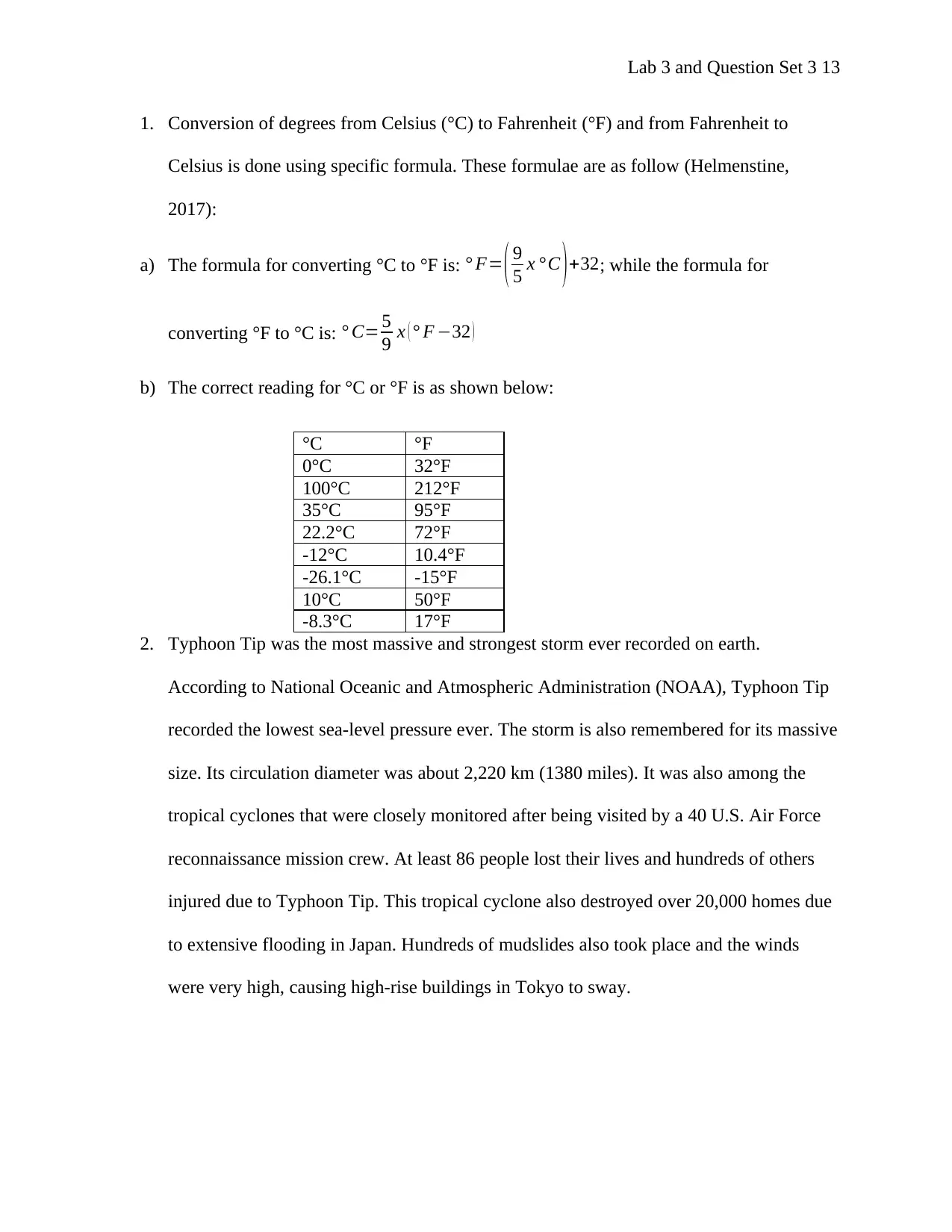
1. Conversion of degrees from Celsius (°C) to Fahrenheit (°F) and from Fahrenheit to
Celsius is done using specific formula. These formulae are as follow (Helmenstine,
2017):
a) The formula for converting °C to °F is: ° F= ( 9
5 x °C ) +32; while the formula for
converting °F to °C is: ° C= 5
9 x ( ° F −32 )
b) The correct reading for °C or °F is as shown below:
°C °F
0°C 32°F
100°C 212°F
35°C 95°F
22.2°C 72°F
-12°C 10.4°F
-26.1°C -15°F
10°C 50°F
-8.3°C 17°F
2. Typhoon Tip was the most massive and strongest storm ever recorded on earth.
According to National Oceanic and Atmospheric Administration (NOAA), Typhoon Tip
recorded the lowest sea-level pressure ever. The storm is also remembered for its massive
size. Its circulation diameter was about 2,220 km (1380 miles). It was also among the
tropical cyclones that were closely monitored after being visited by a 40 U.S. Air Force
reconnaissance mission crew. At least 86 people lost their lives and hundreds of others
injured due to Typhoon Tip. This tropical cyclone also destroyed over 20,000 homes due
to extensive flooding in Japan. Hundreds of mudslides also took place and the winds
were very high, causing high-rise buildings in Tokyo to sway.
Paraphrase This Document
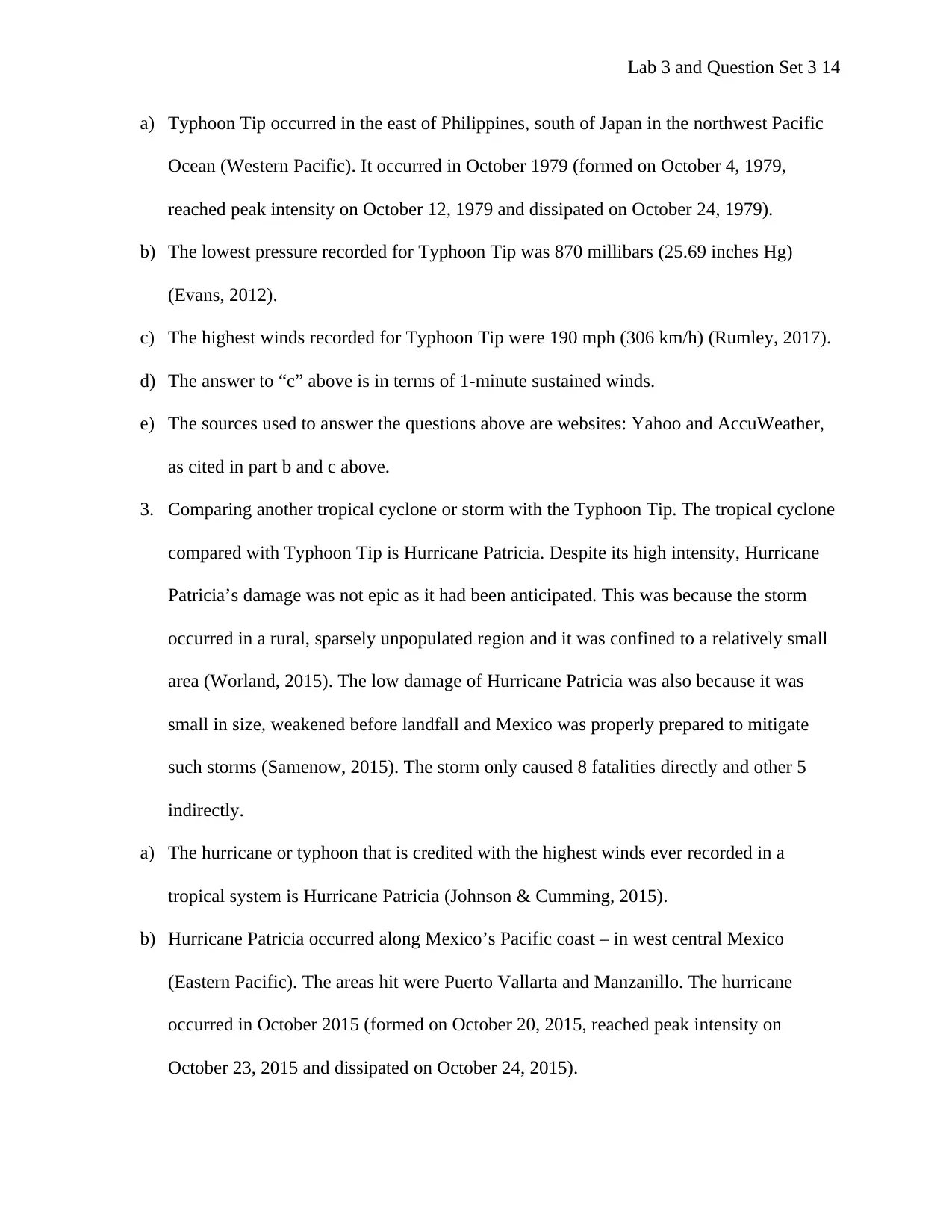
a) Typhoon Tip occurred in the east of Philippines, south of Japan in the northwest Pacific
Ocean (Western Pacific). It occurred in October 1979 (formed on October 4, 1979,
reached peak intensity on October 12, 1979 and dissipated on October 24, 1979).
b) The lowest pressure recorded for Typhoon Tip was 870 millibars (25.69 inches Hg)
(Evans, 2012).
c) The highest winds recorded for Typhoon Tip were 190 mph (306 km/h) (Rumley, 2017).
d) The answer to “c” above is in terms of 1-minute sustained winds.
e) The sources used to answer the questions above are websites: Yahoo and AccuWeather,
as cited in part b and c above.
3. Comparing another tropical cyclone or storm with the Typhoon Tip. The tropical cyclone
compared with Typhoon Tip is Hurricane Patricia. Despite its high intensity, Hurricane
Patricia’s damage was not epic as it had been anticipated. This was because the storm
occurred in a rural, sparsely unpopulated region and it was confined to a relatively small
area (Worland, 2015). The low damage of Hurricane Patricia was also because it was
small in size, weakened before landfall and Mexico was properly prepared to mitigate
such storms (Samenow, 2015). The storm only caused 8 fatalities directly and other 5
indirectly.
a) The hurricane or typhoon that is credited with the highest winds ever recorded in a
tropical system is Hurricane Patricia (Johnson & Cumming, 2015).
b) Hurricane Patricia occurred along Mexico’s Pacific coast – in west central Mexico
(Eastern Pacific). The areas hit were Puerto Vallarta and Manzanillo. The hurricane
occurred in October 2015 (formed on October 20, 2015, reached peak intensity on
October 23, 2015 and dissipated on October 24, 2015).
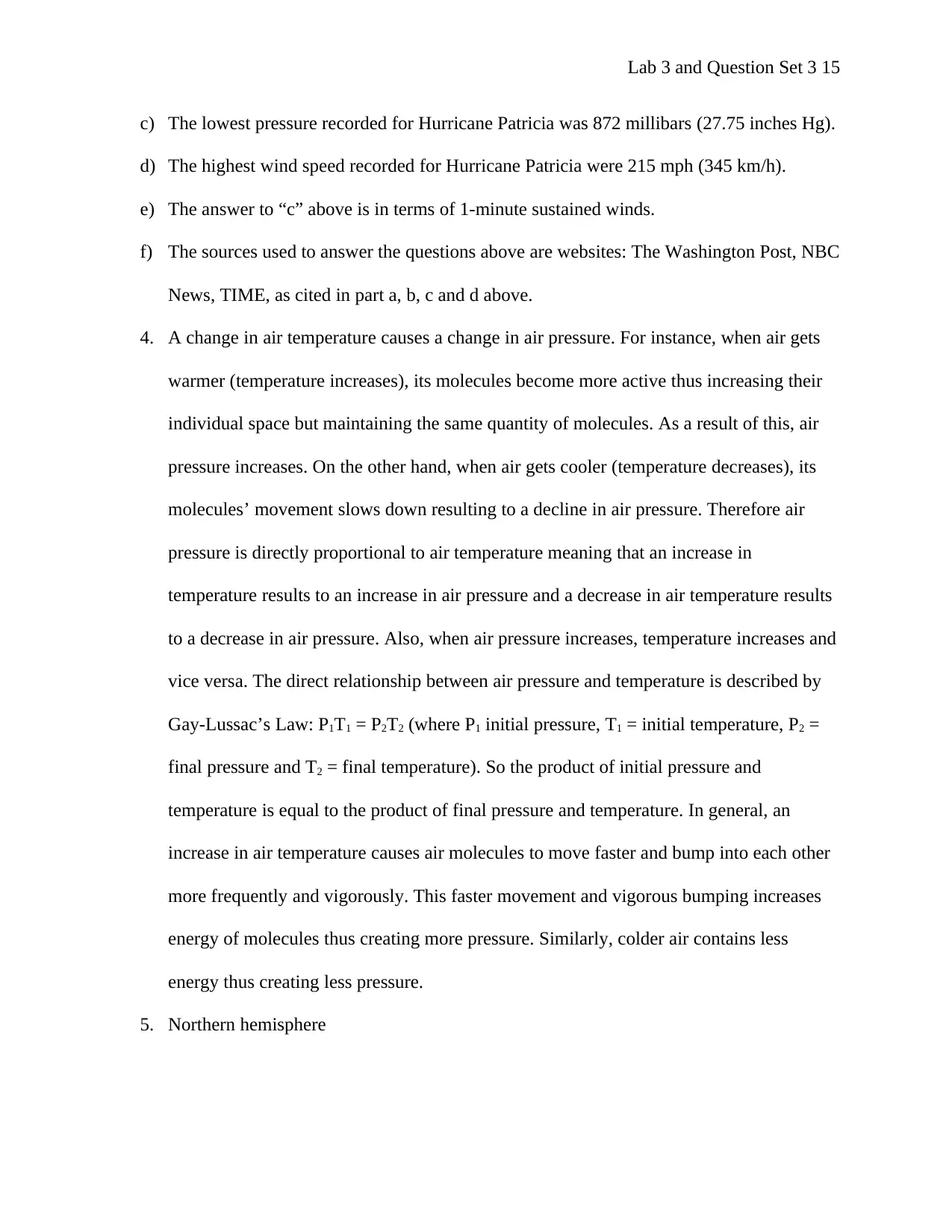
c) The lowest pressure recorded for Hurricane Patricia was 872 millibars (27.75 inches Hg).
d) The highest wind speed recorded for Hurricane Patricia were 215 mph (345 km/h).
e) The answer to “c” above is in terms of 1-minute sustained winds.
f) The sources used to answer the questions above are websites: The Washington Post, NBC
News, TIME, as cited in part a, b, c and d above.
4. A change in air temperature causes a change in air pressure. For instance, when air gets
warmer (temperature increases), its molecules become more active thus increasing their
individual space but maintaining the same quantity of molecules. As a result of this, air
pressure increases. On the other hand, when air gets cooler (temperature decreases), its
molecules’ movement slows down resulting to a decline in air pressure. Therefore air
pressure is directly proportional to air temperature meaning that an increase in
temperature results to an increase in air pressure and a decrease in air temperature results
to a decrease in air pressure. Also, when air pressure increases, temperature increases and
vice versa. The direct relationship between air pressure and temperature is described by
Gay-Lussac’s Law: P1T1 = P2T2 (where P1 initial pressure, T1 = initial temperature, P2 =
final pressure and T2 = final temperature). So the product of initial pressure and
temperature is equal to the product of final pressure and temperature. In general, an
increase in air temperature causes air molecules to move faster and bump into each other
more frequently and vigorously. This faster movement and vigorous bumping increases
energy of molecules thus creating more pressure. Similarly, colder air contains less
energy thus creating less pressure.
5. Northern hemisphere
⊘ This is a preview!⊘
Do you want full access?
Subscribe today to unlock all pages.

Trusted by 1+ million students worldwide
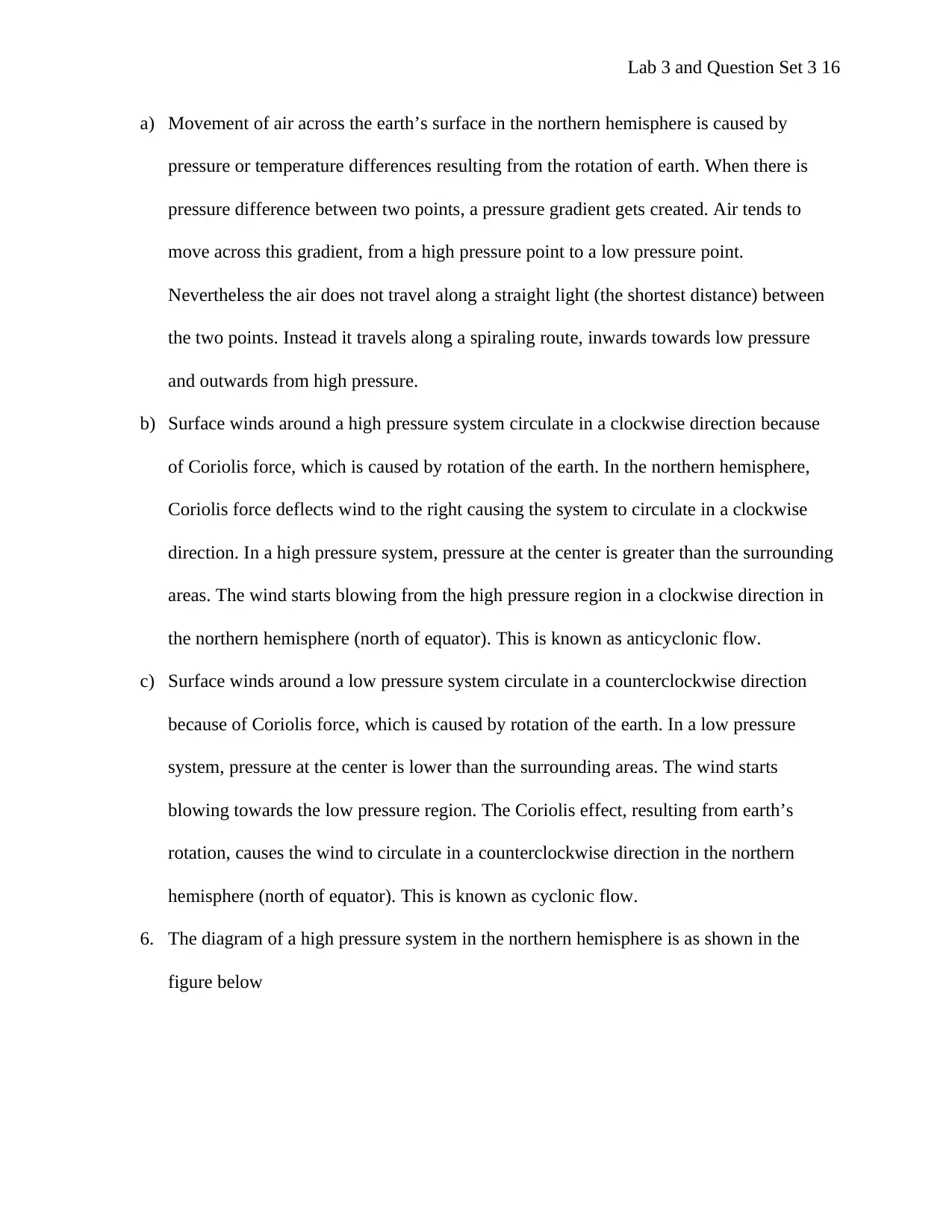
a) Movement of air across the earth’s surface in the northern hemisphere is caused by
pressure or temperature differences resulting from the rotation of earth. When there is
pressure difference between two points, a pressure gradient gets created. Air tends to
move across this gradient, from a high pressure point to a low pressure point.
Nevertheless the air does not travel along a straight light (the shortest distance) between
the two points. Instead it travels along a spiraling route, inwards towards low pressure
and outwards from high pressure.
b) Surface winds around a high pressure system circulate in a clockwise direction because
of Coriolis force, which is caused by rotation of the earth. In the northern hemisphere,
Coriolis force deflects wind to the right causing the system to circulate in a clockwise
direction. In a high pressure system, pressure at the center is greater than the surrounding
areas. The wind starts blowing from the high pressure region in a clockwise direction in
the northern hemisphere (north of equator). This is known as anticyclonic flow.
c) Surface winds around a low pressure system circulate in a counterclockwise direction
because of Coriolis force, which is caused by rotation of the earth. In a low pressure
system, pressure at the center is lower than the surrounding areas. The wind starts
blowing towards the low pressure region. The Coriolis effect, resulting from earth’s
rotation, causes the wind to circulate in a counterclockwise direction in the northern
hemisphere (north of equator). This is known as cyclonic flow.
6. The diagram of a high pressure system in the northern hemisphere is as shown in the
figure below
Paraphrase This Document
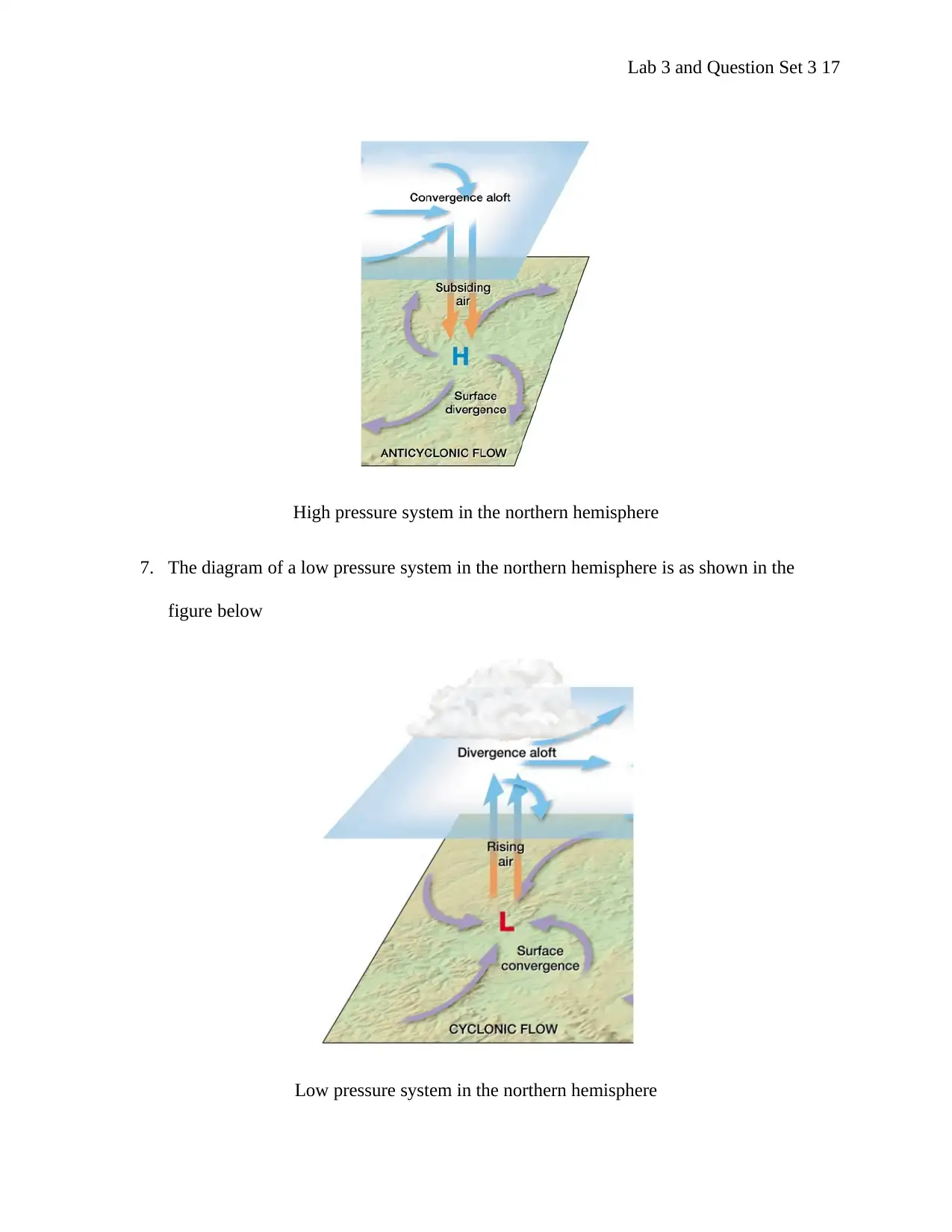
High pressure system in the northern hemisphere
7. The diagram of a low pressure system in the northern hemisphere is as shown in the
figure below
Low pressure system in the northern hemisphere
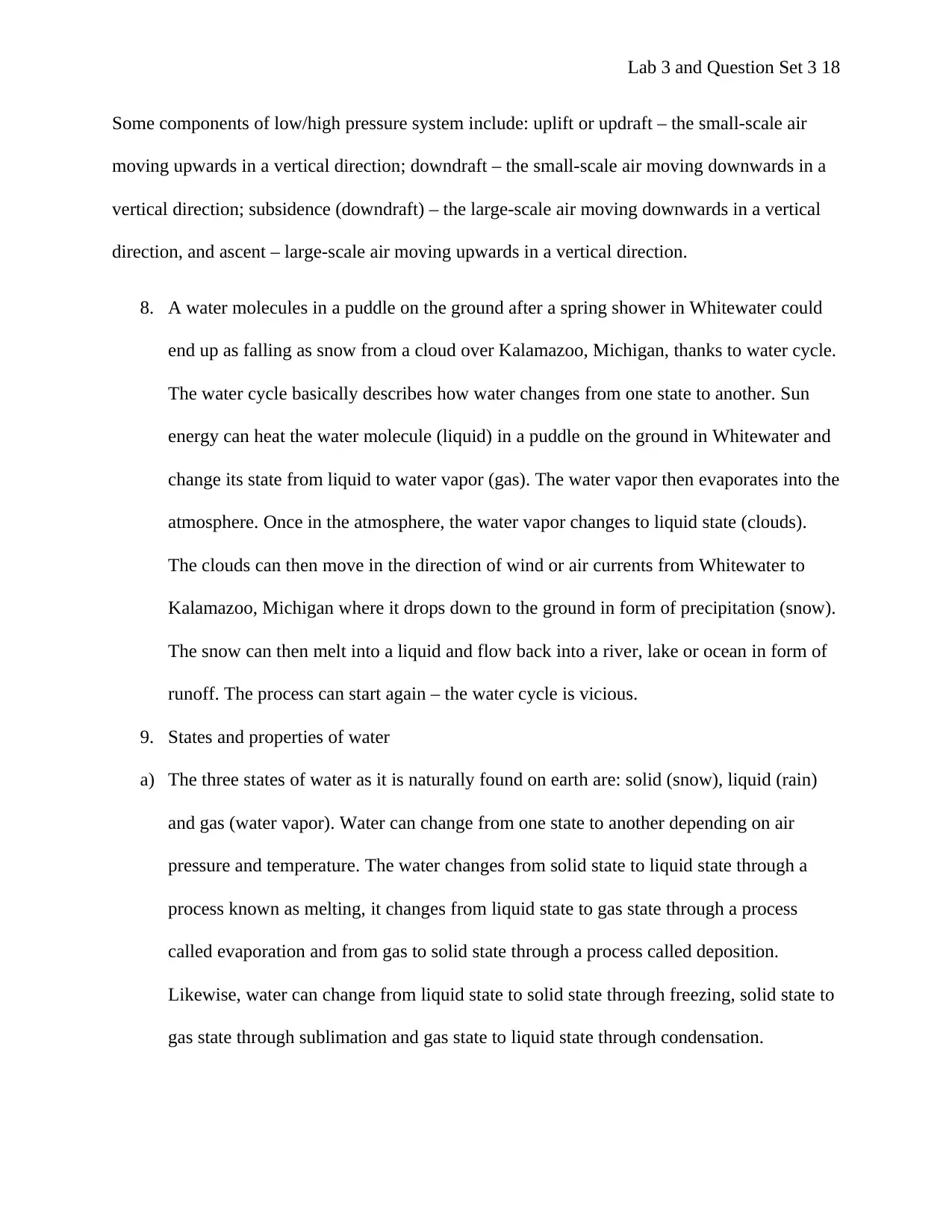
Some components of low/high pressure system include: uplift or updraft – the small-scale air
moving upwards in a vertical direction; downdraft – the small-scale air moving downwards in a
vertical direction; subsidence (downdraft) – the large-scale air moving downwards in a vertical
direction, and ascent – large-scale air moving upwards in a vertical direction.
8. A water molecules in a puddle on the ground after a spring shower in Whitewater could
end up as falling as snow from a cloud over Kalamazoo, Michigan, thanks to water cycle.
The water cycle basically describes how water changes from one state to another. Sun
energy can heat the water molecule (liquid) in a puddle on the ground in Whitewater and
change its state from liquid to water vapor (gas). The water vapor then evaporates into the
atmosphere. Once in the atmosphere, the water vapor changes to liquid state (clouds).
The clouds can then move in the direction of wind or air currents from Whitewater to
Kalamazoo, Michigan where it drops down to the ground in form of precipitation (snow).
The snow can then melt into a liquid and flow back into a river, lake or ocean in form of
runoff. The process can start again – the water cycle is vicious.
9. States and properties of water
a) The three states of water as it is naturally found on earth are: solid (snow), liquid (rain)
and gas (water vapor). Water can change from one state to another depending on air
pressure and temperature. The water changes from solid state to liquid state through a
process known as melting, it changes from liquid state to gas state through a process
called evaporation and from gas to solid state through a process called deposition.
Likewise, water can change from liquid state to solid state through freezing, solid state to
gas state through sublimation and gas state to liquid state through condensation.
⊘ This is a preview!⊘
Do you want full access?
Subscribe today to unlock all pages.

Trusted by 1+ million students worldwide
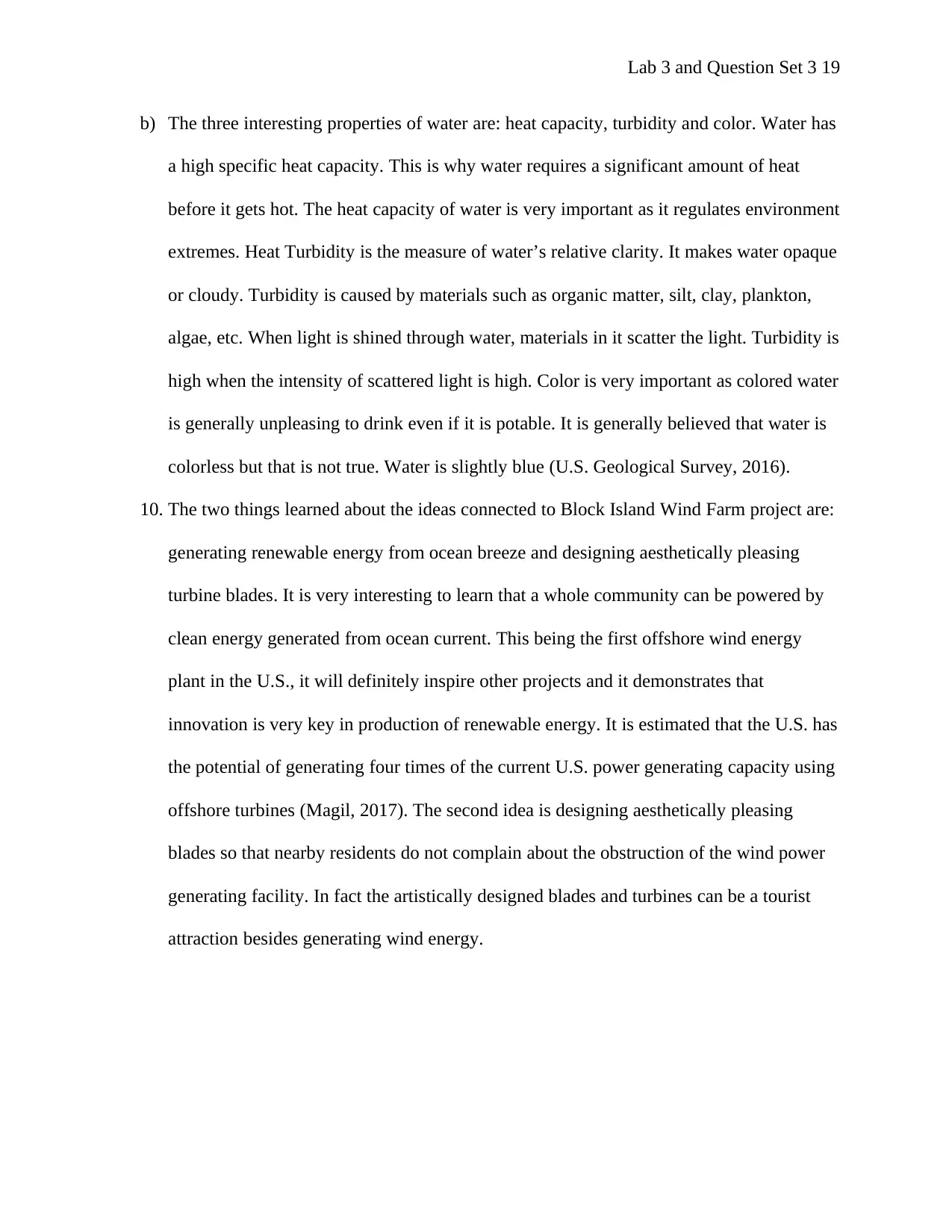
b) The three interesting properties of water are: heat capacity, turbidity and color. Water has
a high specific heat capacity. This is why water requires a significant amount of heat
before it gets hot. The heat capacity of water is very important as it regulates environment
extremes. Heat Turbidity is the measure of water’s relative clarity. It makes water opaque
or cloudy. Turbidity is caused by materials such as organic matter, silt, clay, plankton,
algae, etc. When light is shined through water, materials in it scatter the light. Turbidity is
high when the intensity of scattered light is high. Color is very important as colored water
is generally unpleasing to drink even if it is potable. It is generally believed that water is
colorless but that is not true. Water is slightly blue (U.S. Geological Survey, 2016).
10. The two things learned about the ideas connected to Block Island Wind Farm project are:
generating renewable energy from ocean breeze and designing aesthetically pleasing
turbine blades. It is very interesting to learn that a whole community can be powered by
clean energy generated from ocean current. This being the first offshore wind energy
plant in the U.S., it will definitely inspire other projects and it demonstrates that
innovation is very key in production of renewable energy. It is estimated that the U.S. has
the potential of generating four times of the current U.S. power generating capacity using
offshore turbines (Magil, 2017). The second idea is designing aesthetically pleasing
blades so that nearby residents do not complain about the obstruction of the wind power
generating facility. In fact the artistically designed blades and turbines can be a tourist
attraction besides generating wind energy.
Paraphrase This Document

References
Evans, M., 2012. Earth's Strongest, Most Massive Storm Ever. [Online]
Available at: https://www.accuweather.com/en/weather-news/typhoon-tip-earths-strongest-
storm/87362
[Accessed 25 February 2018].
Harvey, C., 2017. Here's What We Know About Wildfires and Climate Change. [Online]
Available at: https://www.scientificamerican.com/article/heres-what-we-know-about-wildfires-
and-climate-change/
[Accessed 27 February 2018].
Helmenstine, A., 2017. Temperature Coversion Formulas. [Online]
Available at: https://www.thoughtco.com/temperature-conversion-formulas-609324
[Accessed 25 February 2018].
Johnson, A. & Cumming, J., 2015. Hurricane Patricia: Strongest Storm Ever Measured to Hit
Mexico. [Online]
Available at: https://www.nbcnews.com/news/weather/hurricane-patricia-strongest-storm-ever-
measured-hit-mexico-n449731
[Accessed 26 February 2018].
Magil, B., 2017. America's First Offshore Wind Farm Just Shut Down A Diesel Plant. [Online]
Available at: http://www.businessinsider.com/americas-first-offshore-wind-farm-diesel-plant-
block-island-2017-5?IR=T
[Accessed 26 February 2018].
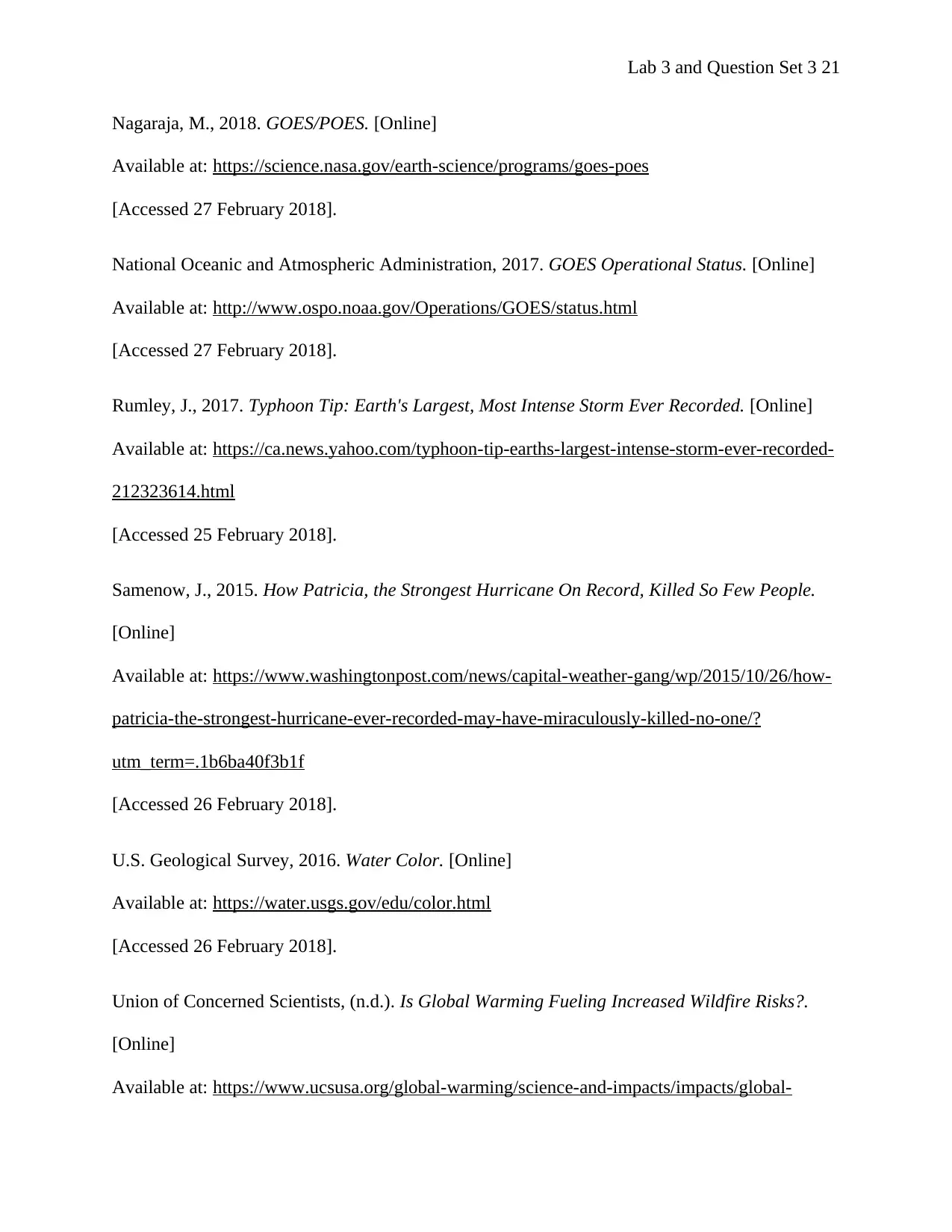
Nagaraja, M., 2018. GOES/POES. [Online]
Available at: https://science.nasa.gov/earth-science/programs/goes-poes
[Accessed 27 February 2018].
National Oceanic and Atmospheric Administration, 2017. GOES Operational Status. [Online]
Available at: http://www.ospo.noaa.gov/Operations/GOES/status.html
[Accessed 27 February 2018].
Rumley, J., 2017. Typhoon Tip: Earth's Largest, Most Intense Storm Ever Recorded. [Online]
Available at: https://ca.news.yahoo.com/typhoon-tip-earths-largest-intense-storm-ever-recorded-
212323614.html
[Accessed 25 February 2018].
Samenow, J., 2015. How Patricia, the Strongest Hurricane On Record, Killed So Few People.
[Online]
Available at: https://www.washingtonpost.com/news/capital-weather-gang/wp/2015/10/26/how-
patricia-the-strongest-hurricane-ever-recorded-may-have-miraculously-killed-no-one/?
utm_term=.1b6ba40f3b1f
[Accessed 26 February 2018].
U.S. Geological Survey, 2016. Water Color. [Online]
Available at: https://water.usgs.gov/edu/color.html
[Accessed 26 February 2018].
Union of Concerned Scientists, (n.d.). Is Global Warming Fueling Increased Wildfire Risks?.
[Online]
Available at: https://www.ucsusa.org/global-warming/science-and-impacts/impacts/global-
⊘ This is a preview!⊘
Do you want full access?
Subscribe today to unlock all pages.

Trusted by 1+ million students worldwide
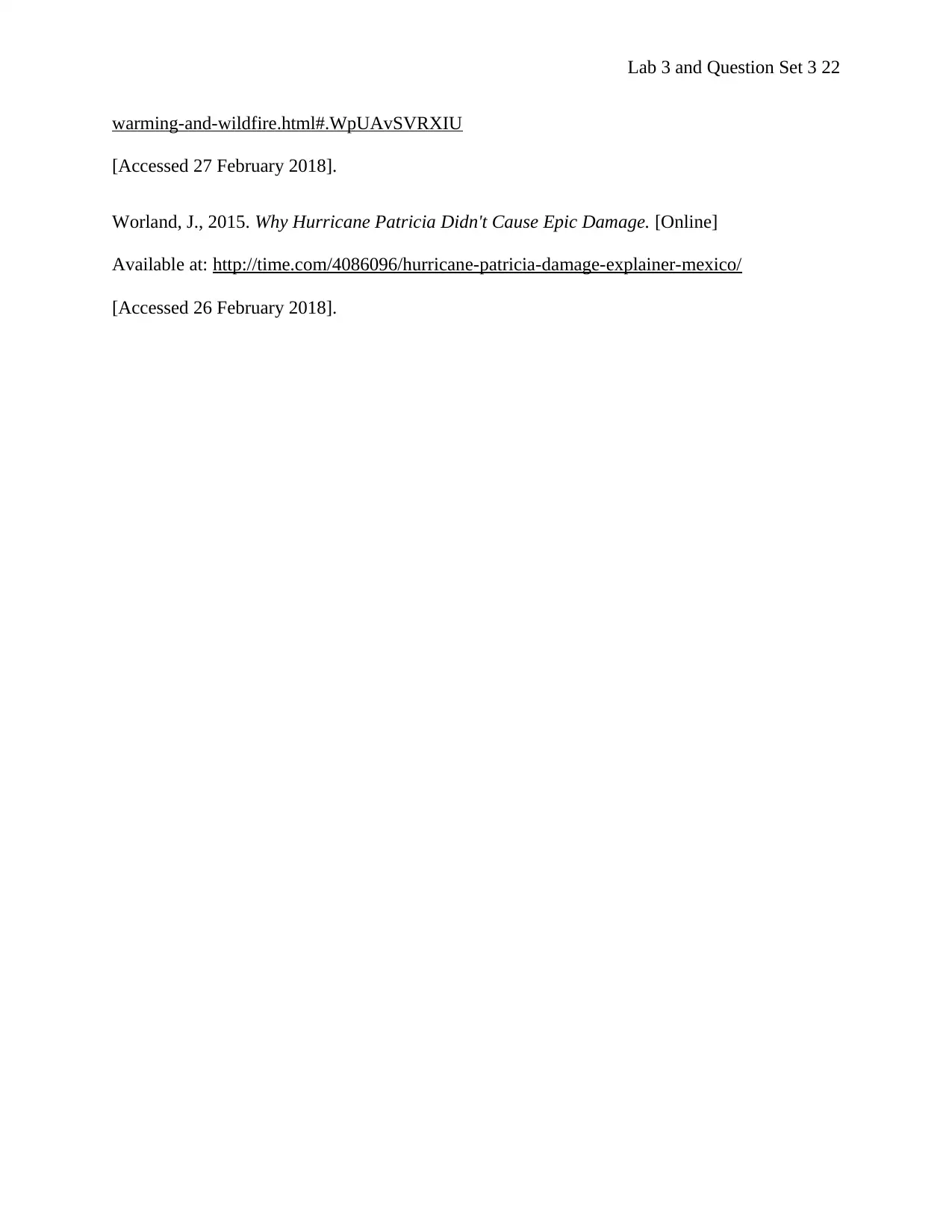
warming-and-wildfire.html#.WpUAvSVRXIU
[Accessed 27 February 2018].
Worland, J., 2015. Why Hurricane Patricia Didn't Cause Epic Damage. [Online]
Available at: http://time.com/4086096/hurricane-patricia-damage-explainer-mexico/
[Accessed 26 February 2018].
Your All-in-One AI-Powered Toolkit for Academic Success.
+13062052269
info@desklib.com
Available 24*7 on WhatsApp / Email
![[object Object]](/_next/static/media/star-bottom.7253800d.svg)
© 2024 | Zucol Services PVT LTD | All rights reserved.
